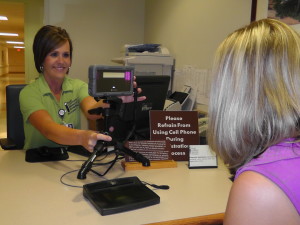Iris Biometrics for Patient Identification in Healthcare Spreading Across the Globe

In case you missed it, there was an excellent article written by Kristen Hallam from Bloomberg News about the increased use of iris biometrics for patient identification in healthcare to help fight medical identity theft, eliminate duplicate medical records, raise patient safety levels, reduce data breaches, and prevent fraud. In the article, Ms. Hallam points out that healthcare providers all around the world are increasingly discovering the benefits of using iris biometrics for patient identification as they search for technology solutions to curb the patient safety perils of fraud, identity theft, and data breaches.
Among the key findings in the article:
- Colorado-based Acuity Market Intelligence forecast predicts that the use of biometrics in healthcare will increase about 20 percent a year to almost $11 billion by 2017
- Iris is the preferred biometric patient identification modality over fingerprint and other hardware because it does not require physical contact by a patient thus supporting hospital infection control initiatives
- Biometrics for patient identification do not require a patient to physically carry any ID card or documentation with them when visiting a medical facility — this prevents swapping and sharing of medical insurance
- Data breaches and subsequent medical identity theft are increasing in healthcare — using biometrics for patient identification helps to lower that possibility and help keep patients safe
- Iris biometric patient identification systems are less expensive than you may think — technology refinements have helped to lower the cost
- Biometrics is not a foolproof way to eliminate medical identity theft — data breaches committed by employees are still a risk
- The U.K. has a growing phenomenon called “shame-based theft in which a patient who doesn’t want his illness to be known seeks care using someone else’s identity
- The iris has so many features that it’s 100,000 times more resistant to false identification than face recognition
- Iris biometrics patient identification systems do not use lasers to scan an eye — instead a high powered digital camera that takes digital pictures of the iris using low-power light-emitting diodes, known as LED lighting is used to capture a photo
A lot of great information about the rising prominence of iris biometrics for patient identification appears in the article including interviews, quotes, and sound bites from the World Privacy Forum, Aoptix, and our own CEO/Founder Mizan Rahman. Special thanks to Kristen Hallam for taking the time to research and write such a informative article!
What other advantages can using biometrics for patient identification bring to the healthcare market?











It’s fantastic to see something new in health care. Health
is wealth and I hope it will not impact up on patient.
Thank you for the comment. It is great to see the healthcare industry embracing this new iris biometric patient identification technology as a means to help reduce fraud at the point of service and eliminate duplicate medical records and overlays. Hopefully as the technology proves itself through positive returns on investment, more healthcare facilities will be willing to evaluate it.
Such a amazing post. Thanks for sharing this post with us.